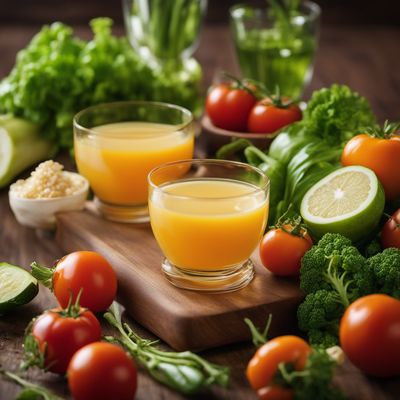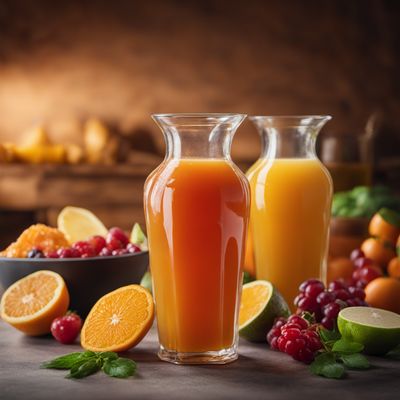
Ingredient
Fruit / vegetable juices and nectars
Liquid Gold: The Essence of Nature's Bounty
Fruit and vegetable juices and nectars are made by extracting the liquid from fresh fruits and vegetables, resulting in a flavorful and nutrient-rich beverage. They come in a wide variety of flavors, colors, and textures, ranging from tangy citrus juices to sweet and velvety nectars. These beverages are known for their vibrant colors, refreshing taste, and ability to provide a concentrated dose of vitamins, minerals, and antioxidants.
Origins and history
The tradition of extracting juices from fruits and vegetables dates back centuries, with evidence of juice extraction techniques found in ancient civilizations such as Egypt and Mesopotamia. Throughout history, juices and nectars have been valued for their nutritional benefits and refreshing qualities. Today, they are enjoyed worldwide and have become an integral part of many cultures and cuisines.
Nutritional information
Fruit and vegetable juices and nectars are packed with essential vitamins, minerals, and antioxidants, making them a nutritious choice. They provide a concentrated source of nutrients and can contribute to a well-balanced diet. However, it's important to note that some commercially available juices may contain added sugars or preservatives, so it's advisable to read the labels and choose options with no added sugars or artificial additives.
Allergens
Fruit and vegetable juices and nectars are generally allergen-free. However, individuals with specific fruit or vegetable allergies should exercise caution and consult with a healthcare professional if unsure.
How to select
When selecting fruit and vegetable juices and nectars, opt for options that are made from fresh, high-quality ingredients. Look for products that are 100% juice or nectar, with no added sugars or artificial additives. Check the expiration date to ensure freshness, and consider choosing organic options for a pesticide-free choice.
Storage recommendations
To maintain the freshness and quality of fruit and vegetable juices and nectars, store them in the refrigerator at temperatures below 40°F (4°C). Once opened, consume the juice within a few days to prevent spoilage. It's important to note that some juices may separate over time, so give them a gentle shake before serving.
How to produce
Producing fruit and vegetable juices and nectars at home is relatively simple. Start by selecting ripe and fresh fruits or vegetables, wash them thoroughly, and remove any seeds, stems, or peels. Use a juicer or blender to extract the liquid, and strain it if desired. Store the juice or nectar in airtight containers in the refrigerator to maintain its freshness and flavor.
Preparation tips
Fruit and vegetable juices and nectars can be enjoyed on their own as refreshing beverages or used as a base for cocktails, smoothies, and mocktails. They can also be incorporated into various culinary creations, such as marinades, dressings, sauces, and desserts. Experiment with different combinations and flavors to enhance your dishes and drinks.
Culinary uses
Fruit and vegetable juices and nectars are widely used in a variety of cuisines around the world. They are commonly available in grocery stores, supermarkets, and specialty food stores. Additionally, many restaurants and juice bars offer freshly squeezed juices and nectars as part of their menu.
More ingredients from this category

Fruit nectars (min. 25-50% fruit as defined in EU legislation)
The Essence of Fruity Delight

Vegetable juices
Vibrant and Nutrient-packed Vegetable Juices

Mixed juices with added ingredients
The Art of Blending: Exploring the World of Mixed Juices

Mixed fruit and vegetable juices
Vibrant Blends of Nature

Fruit juices (100% from named source)
Nature's Nectar: Pure and Refreshing Fruit Juices
Recipes using Fruit / vegetable juices and nectars » Browse all

Lao Chicken Rice Noodle Soup
Savory Delight: Lao Chicken Rice Noodle Soup

Avocado Delight
Creamy Avocado Dream

Nassau Chicken Delight
Tropical Bliss: Nassau Chicken with a Caribbean Twist

South American Almond Cookies
Delicious Almond Delights: South American Almond Cookies

Rojak Bandung with a Twist
Indonesian Fusion Delight: Rojak Bandung with a Twist

Haipai-style Spicy Noodle Soup
Fiery Fusion: Haipai Spicy Noodle Delight

Bún Bò Nam Bộ - Vietnamese Lemongrass Beef Noodle Salad
Zesty Lemongrass Beef Salad: A Burst of Vietnamese Flavors

Savory Southern Soto Betawi
Southern Comfort Soto Betawi: A Fusion of Indonesian and Southern Flavors

Soto Bandung with a Twist
Savory and Spicy Beef Soup with a Refreshing Twist

Indonesian Lamb Soup with Spices
Savory Indonesian Lamb Soup: A Burst of Exotic Flavors

Tom Yum Boran with a Twist
Spicy and Tangy Thai Tom Yum Boran Soup with a Modern Twist

Nouvelle Jibarito
Elevating the Jibarito: A Nouvelle Twist on a Puerto Rican Classic